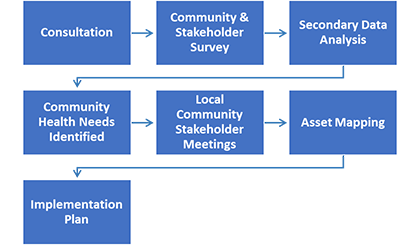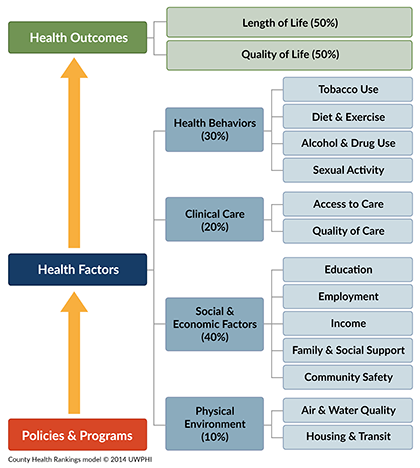Ask A Researcher
April 2022
One Health System’s Approach to Improving Community Health Understanding what the 2021 Community Health Needs Assessment Conducted by Sanford Health means for population health.
Andrew Wiese, Head of Strategic Intelligence at Sanford Health
Karen Olson, Research Specialist with the Center for Social Research at NDSU

Andy Wiese is the head of intelligence for the Strategic Planning team at Sanford Health. He has a bachelor's degree in political science from South Dakota State University and a master’s in business administration from the University of Sioux Falls. A lifelong resident of the Upper Midwest, Wiese is committed to advancing community health.
Karen Olson is a research specialist for the Center for Social Research at NDSU. In this role, Karen’s background in demographics and socioeconomics is used to facilitate the public’s access to data and information needed to make decisions, design and implement programs, and invest in communities across the state. Her efforts involve a wide range of topics including migration, characteristics of the aging population, community efforts to reduce poverty, housing needs, and the health and well-being of children and families.
The overall health of a community depends on the health of the individuals living in the community. While it can be argued a person’s health is a product of medical care and genetics, for many, health and the likelihood of becoming sick and dying prematurely are greatly influenced by factors such as education, income, social determinants and the quality of neighborhood environments. Differences in health along social, economic, racial and ethnic lines exist and often persist across generations.
Finding solutions and improving quality of life, from the perspective of a health care system, begins with understanding the communities it serves and the existing social, economic, and environmental factors that influence a person’s ability to choose paths leading to health.
To this end, the Patient Protection and Affordable Care Act (ACA), enacted March 2010, added a requirement that non-profit medical centers conduct a community health needs assessment (CHNA) every three years. The findings enable health care providers to prioritize the needs of the communities they serve for the purpose of implementing strategies to address those needs. As a result, hospital organizations across the country are actively and regularly engaged with community leaders and residents to explore community strengths and health needs and are held accountable for finding solutions for identified needs.
Sandford Health, one of the largest health systems in the United States, has embraced the community health needs assessment process. Headquartered in Sioux Falls, South Dakota, the organization includes 48 medical centers, 1,494 physicians and 170 Good Samaritan Society senior care locations in 26 states and 10 countries.
“Healthy people create healthy communities and vice versa,” said Dr. Jeremy Cauwels, chief physician for Sanford Health. “The more we know about individual and community health and wellness needs, the more targeted we can be in formulating strategies and allocating resources. Making sure that our resources and desired outcomes are aligned will improve the health of the entire population we serve.”
Throughout the past year, Sanford Health collaborated with multiple health systems, public health agencies, individuals, organizations, stakeholders, and residents in four states to identify the best strategies to improve the health of communities they serve. To assist in this effort, Sanford Health contracted with the Center for Social Research at North Dakota State University, an applied social science research unit, to analyze the information collected through the assessment process in order identify priority health needs specific to each community.
The following section outlines the process Sanford Health utilized to develop strategies and implementation plans addressing significant health needs over the next three years.
2021 Community Health Needs Assessment (CHNA) for Sanford Health – The Process

Consultation. Sanford Health, in coordination with local public health experts, community leaders, and other health care providers throughout the organization’s footprint, developed a multi-faceted assessment program designed to be comprehensive and inclusive. The process maximizes community input and decision-making opportunities, and is built on reliable, existing health data.
Community and Stakeholder Survey. An online survey, aligned to social determinants of health, was administered from December 2020 through February 2021. Invitations to complete the survey were sent to a sample of people within each identified community served. To further promote community involvement, the survey was also sent to community stakeholders and elected officials with knowledge and connections among medically underserved, low income, and minority populations. Stakeholders were asked to complete the instrument as a resident of the community and to forward the survey to their respective populations for greater involvement.
The survey included questions asking for perspective on community factors that may have influence on people’s health such as the quality of childcare and long-term care; access to nutrition, physical activity, and daily transportation; public safety; affordable housing; employment and economic opportunities; and environmental health. Other questions focused specifically on health care access, quality of care, barriers to care, travel to care, and health insurance. In addition, respondents were given the opportunity to follow up on their answers and provide additional feedback. The full set of questions is available in the appendix of each community report found here.
Secondary Data. The framework for the survey was aligned with the County Health Rankings. County Health Rankings, a program of the University of Wisconsin Population Health Institute, also served as the main secondary data source utilized for the community health needs assessment. Alignment of the survey and secondary data within the Rankings model allowed for greater connection of the data sets.

Health Needs Identified. Sanford Health contracted with the Center for Social Research at North Dakota State University to analyze the data gathered from the online survey as well as secondary data from County Health Rankings.
Survey data were organized into three groups based on the population size of each community: large urban/metro communities, medium-sized communities, and smaller rural communities. Data from each community were analyzed individually and in relation to the group to which they belonged based on population size, for comparison purposes. Data from County Health Rankings (using the same organizational method) were used to augment the findings of a particular community health need – and in some cases used to highlight other priority health needs not identified in the online survey results.
The analysis of data from both the online survey and County Health Rankings resulted in an initial list of priority health needs specific to each community served by Sanford Health.
Community Asset Mapping. Following the initial assessment, Sanford Health conducted asset mapping to locate the various community resources available to address the identified needs. This process helped to identify the gaps in services available for each community.
Community Stakeholder Meetings. After the community health needs and gaps in community resources were identified, community stakeholders were invited to attend a presentation and discussion of the CHNA research findings specific to their community. The meetings brought together a range of community leaders with knowledge of medically underserved, low income, or minority populations. Members of the local public health agencies and Sanford Health were also invited. A list of attendees can be found in the introduction section of each community assessment.
Participants were asked to consider the community health needs that should be further addressed through implementation strategies. The meeting was also intended to serve as a catalyst for future collaboration. The facilitated discussion sought to inform on several aspects:
• What are the biggest challenges/health needs facing your community?
• Does your community have gaps in services, access, or outreach?
• What are the opportunities for having the greatest impact in addressing these health needs?
• Which health needs are most urgent in nature?
• Is there any work currently being done to address these needs?
• Are there existing, yet underutilized resources within the community that could address these needs?
• Which needs fall within the purview of the health care system and which needs do not? Can the non-health care needs be shared with other entities or organizations in the community?
• Is there anything you consider an urgent need that has not been discussed?
Implementation Plan. The community stakeholder meetings identified specific health needs to be addressed within the final implementation plan for 2022-2024. Identified needs were based upon all factors, including primary and secondary data, input from the community stakeholder meeting, and scalability of current hospital programs and resources to address the identified needs efficiently and effectively. Each implementation plan identifies the top two priorities to be addressed, along with the existing activities in place to address them. Goals for each of the priorities are identified along with the additional activities needed, desired outcomes, resources needed to accomplish the activities, leadership, and potential collaborations.
Summary
The 2021 Community Health Needs Assessments and 2022-2024 Implementation Strategies for the Sandford Health System are available online. In addition to the implementation plans, the reports also highlight the many strengths, support, and resources available to residents in the communities served. The reports also include a section detailing progress made on the implementation strategies established in the previous needs assessment completed in 2019.
While the resulting strategies and implementation plans are unique to each community, there were some common themes shared throughout the Sanford footprint. Two of the issues receiving most attention involved mental and behavioral health. Concerns for mental health and substance use were a prioritized health issue identified in nearly every community. This health need is acknowledged as one of the most pressing concerns in communities served by Sandford Health.
The purpose of a community health needs assessment is to develop a global view of population health and the prevalence of disease and health issues within a community. Findings from this assessment serve as a catalyst to align expertise and develop a plan of action. There is great intrinsic value in a community health needs assessment when it serves to identify and address public health issues from a broad perspective. A community health needs assessment identifies the community’s strengths and areas for improvement and is vital to investment strategies and programs that build on community assets, promote collaboration, improve community health, and promote innovation and research.
